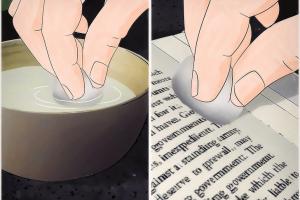Ultimate Guide to Cleaning Paper: How to Effectively Remove Stains

-
Quick Links:
- Introduction
- Understanding Paper Types
- Common Paper Stains and Their Sources
- Effective Cleaning Methods
- Step-by-Step Guide to Cleaning Paper
- Case Studies & Real-World Examples
- Expert Insights on Paper Care
- Preventative Tips for Paper Care
- Conclusion
- FAQs
Introduction
Paper is an essential material in our lives, serving various purposes from writing and printing to art and documentation. However, it is also susceptible to stains and damage. In this comprehensive guide, we will explore effective ways to clean paper and remove stains, ensuring that your documents and artworks remain in pristine condition.
Understanding Paper Types
Before diving into cleaning methods, it's vital to understand the different types of paper and their unique properties. Paper can be categorized into fine art paper, regular printing paper, newsprint, and more. Each type reacts differently to cleaning agents.
Types of Paper
- Fine Art Paper: Used for prints and artistic works; usually more delicate.
- Newsprint: Low-quality paper that yellow and deteriorates quickly.
- Cardstock: Thicker and sturdier, often used for cards and crafts.
- Recycled Paper: Made from recycled materials; may have different cleaning needs.
Common Paper Stains and Their Sources
Understanding the source of stains can help in choosing the right cleaning method. Here are some common stains:
- Ink Stains: Often from pens or printers.
- Food and Drink Spills: Coffee, tea, and juice can leave marks.
- Water Damage: Can cause warping and discoloration.
- Grease Marks: Common in documents handled with oily hands.
Effective Cleaning Methods
Various methods exist for cleaning paper, but caution is essential to avoid further damage. Here are some effective techniques:
Dry Cleaning Methods
- Brush Method: Use a soft brush to gently remove dust and dirt.
- Eraser Method: A white vinyl eraser can help lift pencil marks.
- Sticky Tape: Can be used to lift off small debris without leaving residue.
Wet Cleaning Methods
Wet cleaning should be approached with caution:
- Water Damping: Lightly dampen a cloth and gently blot the stain.
- Alcohol for Ink Stains: Rubbing alcohol can help dissolve ink but must be used sparingly.
- Vinegar Solution: A diluted vinegar solution can help with certain food stains.
Step-by-Step Guide to Cleaning Paper
Follow these steps to effectively clean paper:
Step 1: Assess the Damage
Determine the type of paper and the nature of the stain. This will guide your cleaning approach.
Step 2: Gather Your Supplies
Collect necessary supplies such as a soft brush, eraser, cloth, water, and cleaning solutions.
Step 3: Test a Small Area
Before applying any cleaning method, test it on a small, inconspicuous area of the paper.
Step 4: Apply the Cleaning Method
Gently apply your chosen cleaning method, being careful not to oversaturate the paper.
Step 5: Allow to Dry
Let the paper air dry completely before handling it further.
Case Studies & Real-World Examples
Case studies provide practical insight into the effectiveness of various cleaning methods:
Case Study 1: Removing Ink from Fine Art Paper
A local artist used a combination of dry erasing and a gentle vinegar solution to successfully remove ink stains without damaging the artwork.
Case Study 2: Restoring Old Family Documents
Using a soft brush and careful water dampening, a historian restored damaged historical documents for a local archive.
Expert Insights on Paper Care
Experts recommend regular care and cleaning as preventative measures to maintain paper quality. Here are key insights:
- Store paper in a controlled environment to prevent moisture damage.
- Regularly dust documents to prevent dirt build-up.
- Use acid-free materials for storage to avoid yellowing.
Preventative Tips for Paper Care
To avoid stains in the first place, consider these preventative measures:
- Avoid eating or drinking near important documents.
- Handle papers with clean, dry hands.
- Store papers in acid-free folders or boxes.
Conclusion
Cleaning paper and removing stains can be a delicate process, but with the right methods and understanding, it can be done effectively. Remember to always assess the damage and test any cleaning method before applying it widely.
FAQs
1. Can I use water on all types of paper?
Not all paper types can withstand water. Test first!
2. What is the best way to remove ink stains?
Using rubbing alcohol can be effective, but test on a small area first.
3. How can I prevent paper from yellowing?
Store in acid-free materials and avoid direct sunlight.
4. Is it safe to use an eraser on paper?
Yes, but use a white vinyl eraser to avoid discoloration.
5. What should I do if my paper is warped?
Gently flatten it under a weight once dry.
6. Can I use household cleaners on paper?
It's best to avoid household cleaners as they may contain chemicals that can damage paper.
7. How can I restore old photographs?
Consult a professional conservator for best results.
8. Are there professional services for paper restoration?
Yes, many libraries and museums offer restoration services.
9. How often should I clean my documents?
Regularly dust and clean to prevent build-up.
10. What if the stain doesn’t come out?
Consider consulting a professional for stubborn stains.
Random Reads
- How to connect your android to windows 8
- How to send email using telnet
- How to send files to iphone over bluetooth
- How to become microsoft mvp
- Easy ways to reset linksys router password
- How to clean usb c charging port
- How to clean up broken glass
- How to enable developer mode iphone ipad
- How to clean frigidaire dishwasher
- How to clean foggy plastic